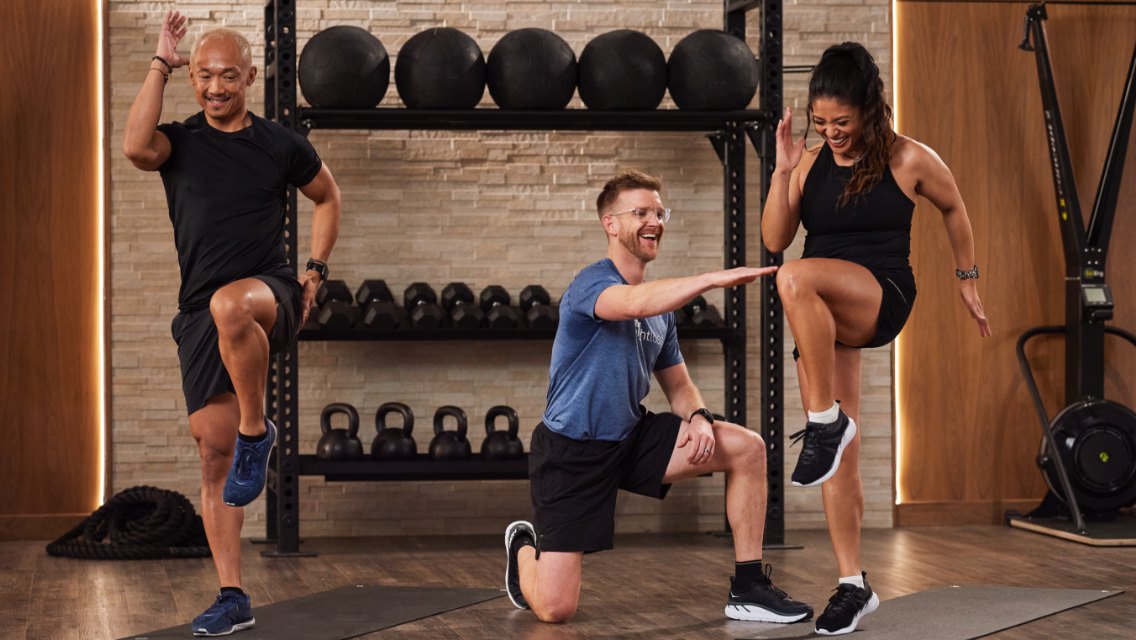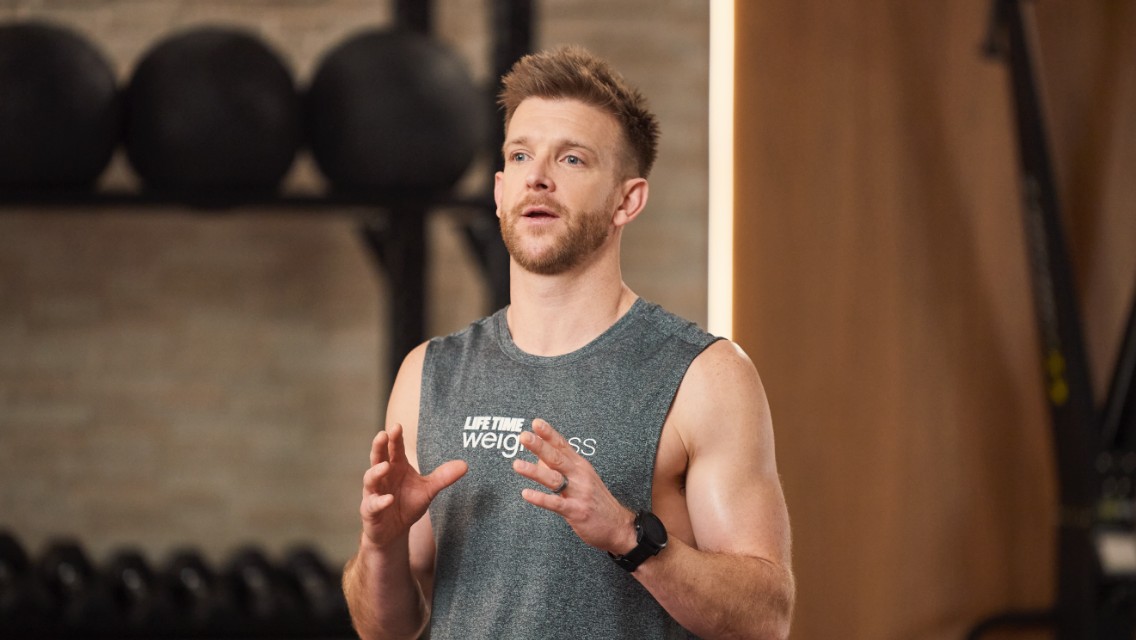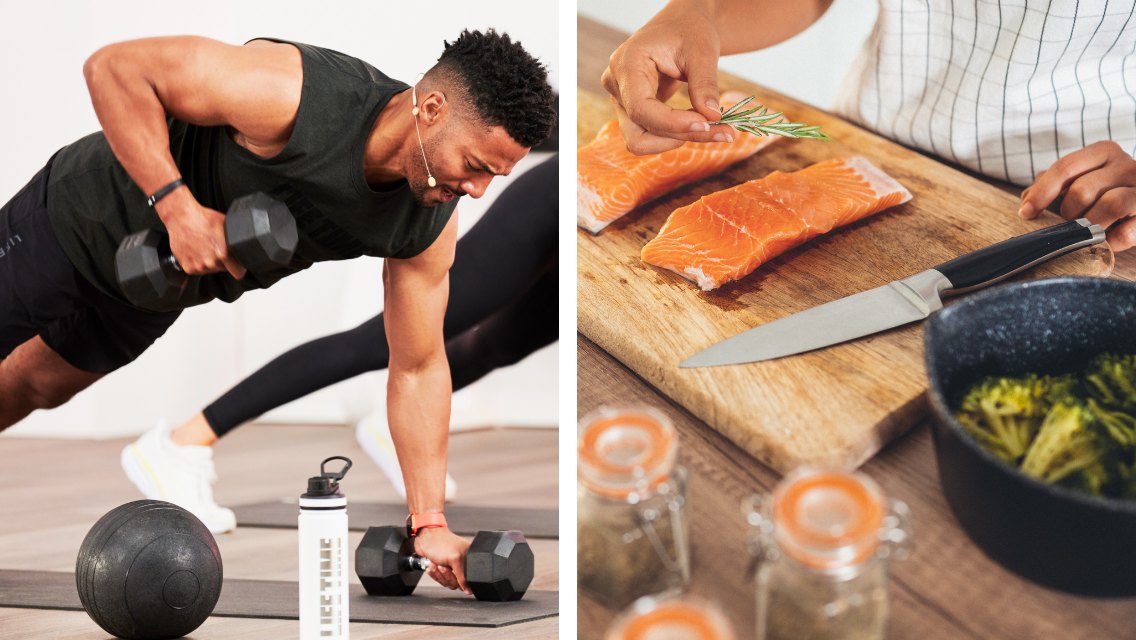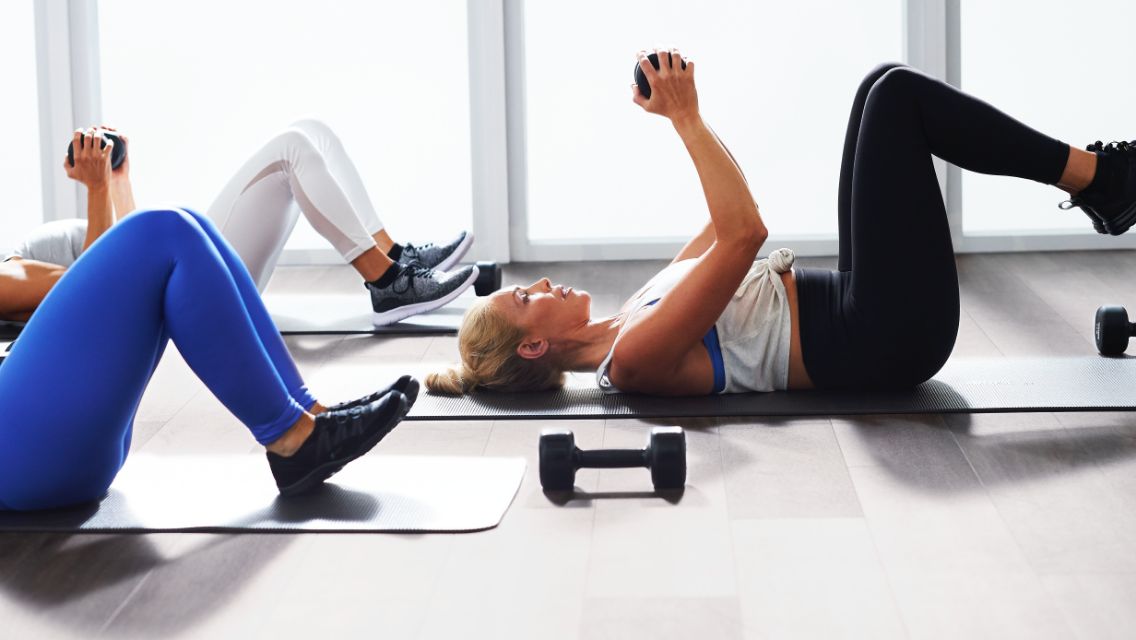When it comes to getting motivated and driving results, there’s no substitute for high-energy support from a knowledgeable and experienced fitness professional.
That vivacity is what Mike Thomson, one of Life Time’s in-club fitness professionals based out of Overland Park, Kansas, delivers to his clients. Thomson is also one of the five dynamic coaches you’ll see in 5/40 FIT, our next-to-launch digital training program. You’ll find a lot of him on the dedicated weekly “power” day in that program.
Mike Thomson, Certified Strength and Conditioning Specialist, Level I USA Track & Field Coach
Thomson has been coaching since 2005 after getting his Bachelor’s degree in Kinesiology from Michigan State University. In addition to his fitness credentials, he is also a Poliquin Biosignature Practitioner.
Thomson was a collegiate soccer player at Michigan State who expanded his athleticism into endurance events. His accomplishments are impressive, including completing the Boston Marathon in 2008 and 2010 and a sub-11-hour finish in his first Ironman at Ironman Cozumel in 2010.
He’s also competed on Team USA in the 2012 Age Group World Triathlon Championships in New Zealand and in 2013, achieved an impressive 2:51 finish at the Chicago Marathon. Currently, he’s training for the 2022 Chicago Marathon where he hopes to run a sub-2:49.
Thomson’s personal life also keeps him busy: He’s a husband and father of twin boys in addition to his coaching role at Life Time. You can find him on Instagram at @fastandfitmike.
Read on to get to know Thomson a little better — and get a taste of his fitness style by trying his favorite workout below.

What does your morning routine look like?
Honestly, I’m way more of a “win the night” guy versus “win the morning.” My nighttime routine is what sets up my morning:
I have to put my shaker cup and smoothie maker on the counter to ensure I get my morning protein shake in. I separate out my supplements on my countertop, prep my food for the next day, and set out my coffee maker.
I also pack my workout clothes and get a giant bag together with everything I need for work to make sure I can take on my day and not get derailed.
This routine makes sure I’m less rushed and that my laziness doesn’t interrupt the start to my day.
When you’re not working or training, what else might you be doing?
In high school, I absolutely fell in love with photography. When I’m taking photographs, I do not have my phone with me, and am focused entirely on what I’m doing. Whether it’s capturing a sunset or moments of my kids playing soccer, photography is my own form of meditation.
Are there any words of wisdom you’d share when it comes to health and fitness?
I’ll let you in on my top three favorite tips:
1. Start with the basics.
More than anything, I want to emphasize that consistent, small progress is always better than making huge, aggressive jumps and gains in your program.
Most people don’t get the very foundational basics right, and they try to jump all the way to the fancy stuff too quickly. Start with prioritizing your sleep, managing your stress, and avoiding added sugar. These are all absolutely crucial to anyone’s success.
Take running as an example: You can’t binge it or run a marathon your first time on the pavement. Instead, it has to be a slow drip of committed, consistent progress in order to build your endurance.
2. Give it time.
One of my past coaches enlightened me with this concept:
When it comes to training, it takes six months to one year to achieve a good level of fitness.
It takes three years to start to see your potential.
But until you train consistently for 10 years, you won’t truly know your potential.
Essentially, whatever your life stage, it’s important to train and to stick with it.
3. Hire a coach.
Although I’m a coach, I’ve never PR’d an event when I had trained for it by myself.
Success involves more than just having knowledge. I am an accountability partner for others, and I myself need an accountability partner. You’ll find that other coaches agree — 12 of my clients who I’m coaching are coaches themselves.
No matter where you are in your journey, I can’t emphasize enough that hiring a coach will expedite your results and your learning.
One hour with a great coach can be worth months of trying to figure it out on your own.
Coach Mike’s Favorite Energy Systems Workout
This personal favorite workout of Thomson’s is designed to help support fat loss while maintaining your strength. It keeps things interesting because it has a little bit of everything in terms of workout style, and it’s adaptable based off your fitness abilities.
This routine challenges your body in three ways, asking you to push your power, strength, and endurance within each block.
The Warm-Up
Perform your choice of aerobic activity (e.g., walking, jogging, or a moving on a piece of cardio equipment such as a rower or elliptical) for eight to 10 minutes.
Start out at a low intensity where it feels easy and like you could go for hours. Then, progressively increase your speed every two minutes.
The last two minutes should feel like a moderate-to-intense effort. Your breathing should be heavy and you should feel like you’re working hard.
The Energy Systems Workout
For each of the circuits below, perform the three movements in order with no break, then take a rest before moving on to the next set. Once you complete four sets of the circuit, move on to the next one.
Circuit 1
| Movement | Repetitions | Tempo | Rest Time Between Sets | Sets |
| Pull-Ups | 4 to 5 | 4010 | 90 to 120 sec
|
4
|
| Barbell Row | 10 to 12 | 3010 | ||
| Erg Rower | 60 seconds | Keep your pace at what you would do for a 500-meter row |
Circuit 2
| Movement | Repetitions | Tempo | Rest Time Between Sets | Sets |
| Barbell Deadlift | 4 to 5 | 4010 | 90 to 120 sec | 4 |
| Dumbbell Walking Lunge | 20 (10 each leg) | 3010 | ||
| Sled Push | 60 seconds | N/A |
Circuit 3
| Movement | Repetitions | Tempo | Rest Time Between Sets | Sets |
| Bench Press | 4 to 5 | 4010 | 90 to 120 sec | 4 |
| Pushups | 10 to 12 | 3010 | ||
| Wall Balls | 25 | N/A |
Breaking Down the Movements
Pull-Ups
- Take an overhand pull-up grip on the bar and hang from it.
- Keeping your arms straight, pull your shoulders away from your ears and your shoulder blades toward your waist (think of performing the reverse of a shrugging movement).
- Keep your chest up and eyes forward, and pull until your chin is higher than the bar.
- Slowly reverse the move, returning to the dead-hang position to complete one repetition.
To make it easier, try a band-assisted pull-up:
- Place a box or bench beneath a chin-up station.
- Hang a heavy exercise resistance band over the bar, then pull the shorter loop through the longer one.
- Stand on the bench and place one foot through the loop.
- Grasp the bar with either an overhand or underhand grip and step off the bench, allowing your arms to straighten fully.
- Keeping your body still, slowly pull yourself upward until your chin clears the bar.
- Reverse the movement and repeat.
Barbell Row
- With your feet slightly wider than shoulder width apart, grip a barbell in front of you with your hands just outside of your legs and palms facing back.
- Hinge at the hips so your chest is about 45 degrees from the floor.
- Draw your shoulder blades together and bend your elbows toward your hips to pull the barbell toward your rib cage.
- Lower the weight with control until your arms are straight and repeat.
Erg Rower
- Start seated in the rower with your hands grasping the handles, hips and knees bent, arms straight, head neutral, back straight, and shoulders level.
- Initiate the drive with your feet. As your legs straighten, lean back slightly and pull the handle toward your body. Finish the pull with your legs straight and the handle at or just below your ribs.
- Return to the starting position by first extending your arms until they are straight, then leaning forward at the hips.
- Once your hands have cleared your knees, allow your knees to bend and gradually slide your seat forward. Repeat.
Barbell Deadlift
- Assuming a shoulder-width stance, feet pointing straight forward or slightly outward, step up to the bar so that your shins are within an inch of the bar, with the bar directly over your mid-foot. From this point on, the bar should remain within an inch of your body. Your shins should be vertical.
- Hinge at the hips and push your butt back as far as you easily can.
- At this point, your hands should be only a few inches from the bar. Bend slightly at the knees until you can grasp the bar.
- With your hands just outside of your legs, grip the bar with a double-overhand grip (both palms facing toward you). This is the grip you will use until the weight is so heavy you feel like your hands will slip off; then you can switch to a mixed grip if you wish.
- Take a breath.
- Get your chest up — someone across the room should be able to read the front of your shirt.
- Push the floor away and stand up with the weight. Exhale as you stand tall with your shoulders back and your chest up at lockout. Your hips should not shoot up before the bar leaves the floor. If your hips move, the bar should move. Repeat.
Dumbbell Walking Lunge
- Grip a dumbbell in each of your hands. Hold your arms straight at your sides throughout the entire movement.
- Stand with your feet shoulder width apart.
- Step forward with one leg, pushing the weight into your heel.
- Bending the knee of your forward leg, lower down and gently touch your back knee to the ground, pausing for one second.
- Push your forward foot into the ground while bringing your opposite leg forward to get yourself to a standing position.
- Repeat this movement, “walking” forward as you lunge, alternating legs.
Sled Push
- Stand behind the weight stack, facing the center of the room.
- Bend forward and place your hands on the handles of the sled, gripping the towel very firmly so the weights won’t budge.
- Lean your weight into the stack.
- Lock your arms, straighten your back, and drive explosively forward with your legs, one at a time, pushing the weight stack across the floor using long, smooth steps.
Bench Press
- With a bench-press-specific bench and rack, set the barbell at an appropriate height so you can unload the bar from the hooks while lying down on a flat bench.
- While seated, set your feet, then lie back so your shoulders and head are on the bench. Squeeze your glutes and brace your abs to protect your lower back, making sure to keep your shoulder blades in contact with the bench.
- Take a wide grasp on the bar so your wrists are stacked over your elbows in the bottom position (bar rested on your chest). It may take a few sets to get this right.
- Unrack the bar from the hooks. Lower the bar down to your chest, directly across the nipple line or slightly below the sternum. Your shoulders should not hike up in this position.
- Eliminate any bouncing or heaving off the chest by bringing the bar to a half-second standstill on your chest before you initiate the press.
- After a brief pause, press the bar back over your chest. The bar path should be straight and stable in each rep and through the entire set.
- Keep your feet on the floor, and your butt, shoulders, and head all in contact with the bench. If you cannot comfortably plant your entire foot on the floor, use a box or plates next to the bottom of the bench as risers for your feet. Repeat.
Pushups
- Position yourself on your hands and knees, placing your hands slightly wider than shoulder width apart.
- Lift your knees off the ground and bring your feet back until your body is in a straight line.
- Keeping your elbows slightly below your shoulders, lower your body until your chest nearly touches the floor.
- Push through the ground to lift yourself back to starting position. Repeat.
Wall Balls
- Stand an arm’s length from a wall. Hold a soft medicine ball at chest level. Inhale to squat down and exhale to quickly stand, driving your hips forward as you extend your legs. Tip: Keep an upright posture with the ball at chest height.
- Rise up, throwing the ball upward with a slight forward arc to hit the wall. Aim 4 to 5 feet above your head. Increase that height to 10 to 15 feet as your skill and power improve. Tip: Direct your gaze up at the spot on the wall where you’re aiming the ball. Tip: Extend your arms overhead to guide the ball while using the power from your hips to achieve height.
- Begin immediately to squat and prepare to catch the ball as it deflects off the wall for the recommended amount of time or repetitions. Perform three rounds of 20 seconds of wall ball tosses, followed by 20 seconds of rest. Tip: Lower into a full, great-form squat at the bottom of each rep. Tip: Move your arms up and down fluidly to the pace of the squat.





